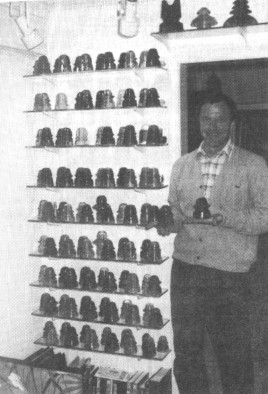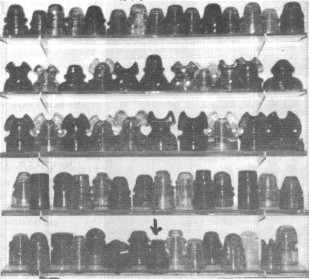Bea Lines
by H.G. "Bea" Hyve
Reprinted from "Crown Jewels of the Wire", July 1986, page 38
Having a best friend is a pleasant and rewarding experience, and it doesn't
happen to everyone. Best Friends Love has been described as "love (that)
grows out of comfortable feelings, close association and shared interests over
a long time." That is the love I share with Charlie Allmon, this month's
interviewee for "Bea Lines".
Charlie was born in Kansas City, MO, on June 2, 1942. He has lived there all his life except for his college years which were spent in Columbia, MO. He is
married to Barbara, and they have a son Mike who is 16. Charlie works full time
for the Kansas City, MO Park Department in their Forestry Division. He is also
owner of a part time self-employed tree service. During the summer months this
second job keeps him very busy, and he often puts in a total of 12 hours a day.
He and Barb met in 1963 while both were attending the U. of MO. It was a college
romance. They started dating the following year. She was living in a sorority
house less then one block from his fraternity house. They graduated together in
1965 and were married July 30, 1966.
Charlie's interest in insulators centers mainly on H. G. Co. glass, and he
has a very colorful and beautiful collection totaling about 100 pieces. However,
he also collects many other types, with his entire collection numbering about
300 pieces (all of which are glass). He displays approximately 250 insulators and keeps very
few that he doesn't display. He states that over the past 8 years, he has given away all of the less valuable
pieces, and even some
intermediate stuff that was no longer displayed. By choosing persons who
expressed some interest in acquiring a collection, he tried to encourage them to
join our hobby by continually giving them insulators that no longer interested
him.

Charlie and his beautiful H. G. Co. collection.
In his left hand is his favorite insulator,
a CD 164 H. G. Co. with sharp
drips in peacock blue.
Let's listen to Charlie as he tells how and when he first discovered insulators. "In
November of 1968 a co-worker of mine
invited me to go pheasant hunting in Iowa. The most popular method in those days
was a lazy man's method called road huntin' . We simply loaded our shotguns, got
into one guy's a car, everyone rolled down their window, and stuck the gun barrel
out. We drove very slowly up and down the rural roads, keeping a watchful eye
on the slowly passing roadside ditches. After about 2 hours of this, everyone
was bored. We drove past an abandoned pushed-over telephone pole and the driver
said, 'Hey! Look at those insulators on the top of that pole. Do you know all
insulators are worth $1.00 each?' Well, instantaneously all four doors flew open
and everyone rushed for the pole. I'll never forget that pole. It had four
Hemingray 42's on it; three were aqua and the other one was that irridescent ice
green. I was the first one to reach the pole so I chose the ice green one,
while everyone else grabbed en aqua. That was my first experience with insulators.

Some of Charlie's general glass.
Arrow shows his 2nd favorite insulator,
the
cobalt Mulford and Biddle.
"From 1968 until 1973 most collectors improved their collections by
actually finding insulators and then trading their duplicates. This was one of
my collecting methods. The other was by assisting an electrical linemen,
whose job allowed him a great deal of work time to actually climb poles and
change out desirable insulators. I assisted him by locating the poles to be
climbed beforehand. Then I would make him a routed list to work from, which
increased his speed and organization. After we accumulated approximately 20
pieces, I would do the selling. In return for wrapping, shipping and selling the
glass, he would give me a sales commission of money or choice insulators. Ha
also made me some very liberal trades."
It was 1969 before Charlie started learning about his newly-acquired hobby.
His first fascination was with all the various name embossings, so that's where
his first effort at specialization was directed. After acquiring a particular embossing
(let's use California as an example) , he then would try to get an
unusual color or shape in that same embossing. But after a few years he realized that
this specialty was really resulting in diversification and not actually going
any specific direction. Then from 1974 to 1976 he went through a period of
relative hobby inactivity. He still subscribed to Crown Jewels and purchased
an occasional insulator, but his primary hobby was his metal detector. He
owned a relatively inexpensive model, but even so, he says he made a killing. He
was the first person to hunt almost all of the old church yards in the KC area,
and also many of the oldest school yards. He never found anything outstanding
such as gold coin, but he did find lots of cheaper gold and silver jewelry, over
$125 in silver coins, and more than $800 in newer "funny money". This
money was later used as a "grubstake" to re-enter our hobby, providing
him with the funds he needed.
Charlie continues, "It was also during this period, as most old-time
collectors will remember, that the practice of trading was giving way to selling. Well, the money
was simply not there for me to buy insulators. My wife and I had bought our home during this time,
and I was not making a large salary. We were in that difficult financial period
which most couples with young children encounter.

More general glass. Second row is all carnival glass.
"After re-entering the hobby I had a much clearer idea of what to
specialize in. The KC area produced a great variety of colors embossed H. G. Co.
These were nearly all on the electric lines in the older sections of the
metropolitan area. Almost all were CD 162's, but I have owned a total of three
peacock blue CD 164's also. Because of the many beautiful ambers, blues, and
even an occasional red, I just seamed to gravitate naturally toward my present
specialty, unusual colors of insulators embossed H. G. Co. My only other
specialty is unusual-colored early threaded stuff. But these appeal to me as much for their distinctive shapes as they do for their unusual color.
"What's the favorite insulator in my collection? Well, that's really a
toughie! But right off the top of my head I would probably say it's my CD 164 H.
G. Co. peacock. I got it in 1969 from a friend of mine who was an electric
lineman.. I stood on the ground beside the pole while he changed it out from a 4,000 volt
cable. He then leaned back and tossed it down to me without any more
warning than a, 'Here, catch!' (I did). If I could choose a second favorite, it
would be my cobalt Mulford and Biddle. (Thanks, Marvin Collins -- it was a long
time ago, wasn't it?) My #1 'want' at this time is an H. G. Co. amber baby
signal, CD 160. I know they ware manufactured. I have also been able to confirm
who recovered several, where they came from, and the name of the old-time
collector who originally owned them.
"My other hobbies include collecting glass canes and glass marbles. I
also quail-hunt, and at the present time I am a volunteer coach for two children's
basketball teams. I also enjoy tennis. My wife's hobbies include
running and tennis. She shares the marble and cane hobbies with me, but she is
definitely NOT interested in insulators. But, it was not always that way.
"During the early years of my hobby involvement Barb went with me on
nearly every insulator hunt. We had a method we used for reaching insulators on
short telephone poles. We placed a small step ladder against the pole and she
would climb to the top of the ladder. Then I would climb the ladder until my
shoulders were even with her feet. She then stepped onto my shoulders, and I
climbed to the top of the ladder.. By doing that, we could reach the top of many
poles. But my wife's interest in this hobby ended one day when a group of
three collectors stopped by our house. They were from out of town, and just stopped in unexpectedly the night
before the start of the
Kansas City National Swap Meet. My wife had never met any of them, and I had
corresponded just a few times with only one of them. Well, shortly after they
arrived (half plastered), one of them turned to her and said, 'Hey, how about
you heading for the kitchen and hustlin' us up some supper?' Well, to put it frankly, that really upset the
apple cart! After that, Barb's interest changed from insulators to involvement in tennis and running.
Charlie is a multi-faceted collector; not only has he written six feature
articles for Crown Jewels, but he presently serves as NIA Show Standards
Chairman, and he does an excellent job in both areas. He says that he hopes to
write more articles in the future. His well-written, down-to-earth articles are
a pleasure to read (and we're looking forward to more, Chuck). Regarding his
show chairmanship, I'd like to add my own words of appreciation to those I've
heard from a great many others in the hobby. It concerns Charlie's presentation
of the awards last summer at the St. Charles National banquet. Along with his
presentations, Charlie mentioned an outstanding characteristic in each display, encouraging everyone to go back the
next day and take a second look at that particular display and item. This
innovation was extremely well received, and hopefully it will become an
on-going feature at all future awards presentations.

Charlie with his H. G.'s and Postal Telegraph clock.
Clock has green neon
tube and is an outside clock,
apparently from the Denver area.
There are many ways in which one could describe Charlie, but here are a few
we can print; hard-working, good-natured (usually), fun-loving, sort of bratty,
and fun to be with (most of the time). He's definitely one of the most intense persistent, and
zealous insulator collectors (especially of H. G. Co. glass) in
the country, if not the entire world. (And Charlie, you're the very best
Best
Friend there is).

More recent photo of Charlie's
H. G. collection. Note the
four different CD 196 tramps.
Arrow shows his CD 196 in greyish SCA.
|
